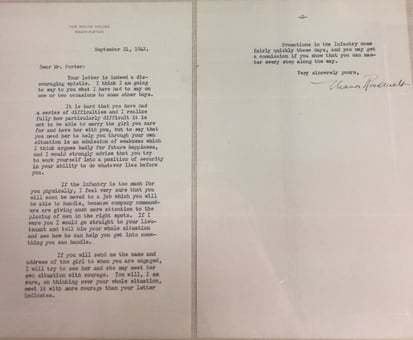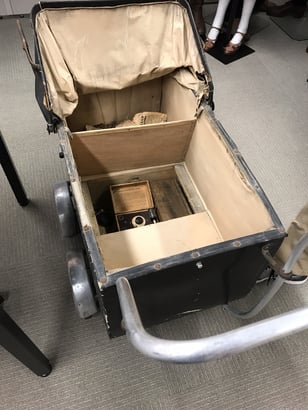The International World War II Museum in Natick , Massachusetts has a collection which comprises over 7,000 objects, 500,000 documents, 3,500 posters and 7,500 books. “The documents include the famous and infamous: an original copy of the Versailles Treaty of 1919 to the Munich Agreement of 1938; the letters written by Eisenhower and Rommel to their wives on D-Day. The objects range from uniforms and military equipment to the more personal items that belonged to members of the Resistance, families on the home fronts or prisoners of war.”
This fall fourteen students visited the International Museum of World War II as part of their World War II class. Divided into pairs, each group was assigned a specific aspect of the war on which to focus and later report. They made their way through the museum, taking notes on topics, such as the military, political, and civilians heroes of the war; the impact of propaganda and correspondence on the course of the war; applying the statement, “Necessity is the mother of invention to innovative technology; and interpreting a 1999 quotation by Senator John McCain on war’s “cruel reality.” Below are some excerpts from students' reflection on their visit:
Annie Berrie:
![IMG_0520[1].jpg](https://info.taboracademy.org/hs-fs/hubfs/IMG_0520%5B1%5D.jpg?width=362&name=IMG_0520%5B1%5D.jpg) While at the International World War II Museum in Natick, Massachusetts, I was able to explore some of the written work that was sent and received during the war. The museum had a vast collection of letters, some personal and some political and many were written by some of the most distinguished people of the times, such as Eisenhower, Roosevelt, Patton, and the Royal Family. Amongst the impressive collection of artifacts was the Royal Family Christmas card, letters that Eisenhower had written to his wife, and many letters that Eleanor Roosevelt sent out during her time in the White House. Although almost every letter was written with a different purpose, looking back at them, more than 50 years later, it is obvious that there was an underlying similarity between all of the letters.
While at the International World War II Museum in Natick, Massachusetts, I was able to explore some of the written work that was sent and received during the war. The museum had a vast collection of letters, some personal and some political and many were written by some of the most distinguished people of the times, such as Eisenhower, Roosevelt, Patton, and the Royal Family. Amongst the impressive collection of artifacts was the Royal Family Christmas card, letters that Eisenhower had written to his wife, and many letters that Eleanor Roosevelt sent out during her time in the White House. Although almost every letter was written with a different purpose, looking back at them, more than 50 years later, it is obvious that there was an underlying similarity between all of the letters.
 Every letter I read that afternoon at the museum, showed some sign of how tragic war was. Whether it was Eisenhower writing home to his wife describing the fear that he has for the uncertainty of the future or Eleanor Roosevelt reaching out to a unit of men encouraging them to keep fighting for soon they will understand the purpose; each letter showed that war was something that had to be done, but nobody enjoyed doing it. Commanders didn’t like the unknown, soldiers didn’t like being away from home, and the families at home didn’t like the constant fear of whether or not their loved one would be alive the next day. Although nobody enjoyed war, they had to fight for their country. Yes, in some of these letters I saw fear, worry, and hopelessness, but the trait that was present in each letter, was sacrifice. The person who was writing each letter was making a major sacrifice, they were putting their lives on the line everyday to protect their people back home.
Every letter I read that afternoon at the museum, showed some sign of how tragic war was. Whether it was Eisenhower writing home to his wife describing the fear that he has for the uncertainty of the future or Eleanor Roosevelt reaching out to a unit of men encouraging them to keep fighting for soon they will understand the purpose; each letter showed that war was something that had to be done, but nobody enjoyed doing it. Commanders didn’t like the unknown, soldiers didn’t like being away from home, and the families at home didn’t like the constant fear of whether or not their loved one would be alive the next day. Although nobody enjoyed war, they had to fight for their country. Yes, in some of these letters I saw fear, worry, and hopelessness, but the trait that was present in each letter, was sacrifice. The person who was writing each letter was making a major sacrifice, they were putting their lives on the line everyday to protect their people back home.
I found these letters to be really interesting because they gave you a personal insight into what life was like during the war. You got to experience people’s raw emotions and read personal stories of the people that you read about every day in history. If you ever have the chance to visit the museum, I highly encourage you to do so. It will give you a greater appreciation for everyone involved in WWII and leave you with a better understanding of the war itself.
Kelsey Boch and Megan Carchidi:
The horrors of war have the ability to change anything from terrain to a man’s psychological well-being and they are even able to transform the most powerful people of an era. Dwight D. Eisenhower, Supreme Allied Commander
.jpg?width=441&name=IMG_1545%20r%20(1).jpg)
during the war, was profoundly affected as seen in a letter that he wrote to his wife on December 4th, 1943, on display in the museum, in which he expressed that while the war had dramatically impacted his life, his love for her never wavered. He wrote to his wife, “I love you! I wish I could see you an hour to tell you how much!” In contrast to this statement he spoke of how all he had seen in war had forever changed him forever as man and a husband. Even a man of that magnitude supports John McCain’s idea that, “War is wretched beyond description.”
This barely begins to cover the magnitude of how truly horrific World War II was in every aspect. We were able to witness some first hand accounts of unimaginable inhumanities. “Nothing, not the valor with which it is fought nor the nobility of the cause it serves, can glorify war.” This quote by John McCain exemplifies the trials and tribulations that all must go through during war. After reading this quote and visiting the museum in Natick, we can confidently say the ends do not always justify the means.
Jon Svendsen and Kyler Myer:
The World War II museum in Natick, Massachusetts has an abundant amount of information. Interestingly, they have a lot of civilian groups and individuals that helped influence the war. Some examples of specific civilian heroes of war are women, children, Resistance fighters, Holocaust survivors, and Japanese-Americans.
 The women involved in World War II took many risks contributing to their side. For example, the museum displayed a baby carriage, which had the capability to hide and smuggle electronics through Nazi occupied France. They would open the compartment and store contraband, while the baby acted as a disguise. These women acted like heroes because they not only helped give their government the edge during the war, but they not only risked their lives, but also their kids when the consequences were so tough.
The women involved in World War II took many risks contributing to their side. For example, the museum displayed a baby carriage, which had the capability to hide and smuggle electronics through Nazi occupied France. They would open the compartment and store contraband, while the baby acted as a disguise. These women acted like heroes because they not only helped give their government the edge during the war, but they not only risked their lives, but also their kids when the consequences were so tough.
In Great Britain, civilians were given many roles to keep the population of London and other parts of England safe during The Battle of Britain. From sounding a siren(pictured left) to making sure the people of London had their gas masks, they acted diligently to keep Britain safe and alert. Mauricette Lebron, was a fearless child during World War II. She used a sewing kit to smuggle messages to other resistance fighters in France.
Both the baby carriage and the sewing kit show the ingenuity that the French developed to keep Germans off their trail, which resulted in their success during World War II.
 The Heroes were also Japanese-Americans. Mr. Kasei was a second generation Japanese- American who served the United States, while his wife and parents were kept in internment camps. Mr. Kasei served in North Africa until he was shot by a stray bullet. He received the Purple Heart after his injury at war.
The Heroes were also Japanese-Americans. Mr. Kasei was a second generation Japanese- American who served the United States, while his wife and parents were kept in internment camps. Mr. Kasei served in North Africa until he was shot by a stray bullet. He received the Purple Heart after his injury at war.
The Museum depicted Anne Frank's signature, which is one of only two known to have survived the war. Her diary recorded the injustices that Jewish people had to endure on a daily basis during World War II. The Nazis took away every right that the Jews ever had and dehumanized them to the point of starvation and death and this was evident in the exhibit.
Many individuals took incredible risks to protect their freedom and support their side during the war. They did unthinkable things to keep not only themselves safe, but also their families and people. The International Museum of World did an unbelievable job of depicting the civilian heroes of World War II.








